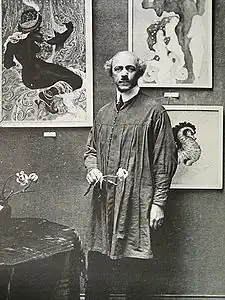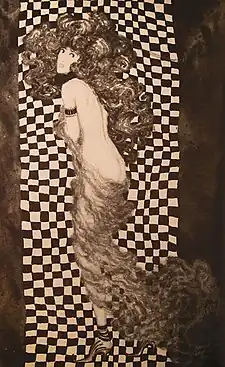

Nikolai Konstantinovich Kalmakov, known as Nicholas Kalmakoff (Russian: Николай Константинович Калмаков; 23 January 1873, Nervi, Italy – 2 February 1955, Chelles, France), was a Russian symbolist painter, graphic artist, and set designer whose work is characterized by motifs dealing with spirituality, occultism and sexuality.[1]
Biography
He was born to a Russian general who was living in Italy and had married there. His interest in occultism may have been sparked when he was introduced to the tales of the Brothers Grimm and E. T. A. Hoffmann by his German governess. Around 1890, his family moved back to Russia and he graduated from the Imperial School of Jurisprudence in 1895.[2] Following that, he returned to Italy, where he became self-taught in painting and anatomy.[1]
By 1900, he was once again in Russia; dividing his time between St. Petersburg and Moscow. Although he preferred to work in isolation, he maintained loose contacts with some artists' associations and the St. Petersburg theater world, where he caused a sensation with elaborate and taboo-breaking costumes and stage designs. He also worked as a book illustrator and made personalized bookplates.
Shortly after the start of the First World War he was drafted, but spent only a short time in combat before being transferred to work in a field hospital. In 1920, during the Civil War, he left Russia and made his way to France. From 1924, he lived a reclusive life in Paris. An attempt to re-establish himself as a set designer was unsuccessful. His work remained little known and he died in obscurity, at a nursing home in Chelles.[1]
Seven years after his death, in 1962, the art collectors Bertrand Collin du Bocage and Georges Martin du Nord discovered samples of his abandoned work in a large flea market to the north of Paris. Kalmakoff's works were finally exhibited at the Galerie Motte in February 1964.
In Russia, his works may be seen at the Russian Museum, the Tretyakov Gallery, the Bakhrushin Museum and the Pushkin Museum.
References
- 1 2 3 Biography of Kalmakov @ Maslovka
- ↑ "List of former pupils of the Imperial School of Jurisprudence, who completed the course of sciences there from 1840–1917" by N. Pashenny (1967)
Further reading
- "Kalmakoff: the Angel of the Abyss, and the Painters of Mir Iskusstva", Jean-Hugues Piettre, ed., Musée-Galerie de la Seita (1986, exhibition catalog)
- E. Strutinskaya, "'The only one of its kind', Nikolai Kalmakov". In: Documents and facts from the history of the Russian theater of the XX century, Issue #3, V. V. Ivanov publishing (2004)
- John Ellis Bowlt and Yulia Balybina: "Nikolai Kalmakov", Искусство XXI век (Series:Художники русской эмиграции) ISBN 978-5-98051-050-3 (2008)
External links
- Works by Kalmakoff @ ArtNet
- Kalmakoff, the Forgotten Visionary @ Visionary Revue
- "The Triumph of Passion: Nicholas Kalmakoff's Temptresses and Demons" (Artists of the Weird World # 1) @ A Thing of Oddness